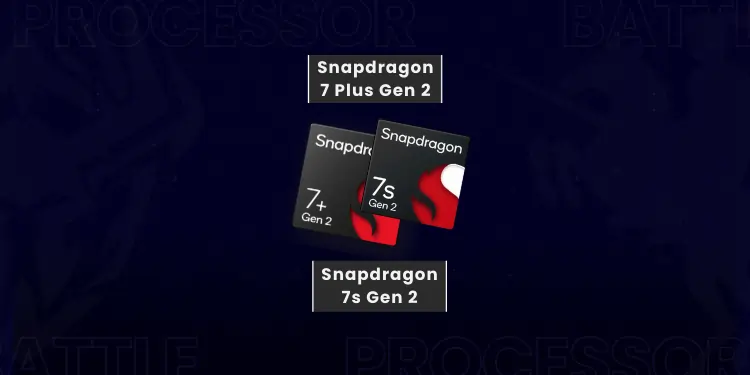Snapdragon 7s Gen 2 vs 7 Plus Gen 2: In the era of smartphone technology, the battle for supremacy among processors is relentless. Giants like Qualcomm and MediaTek engage in an incessant bout, striving to power smartphones of every type. The market has become so tough that even the brands themselves have created an internal struggle between their own processors. For instance, Qualcomm’s Snapdragon 7 Gen 2 has successfully overtaken the Snapdragon 888, a processor that has powered almost every flagship smartphone. 7 Gen 2, on the other hand is tailored for budget smartphones. This unexpected triumph underscores the dynamic nature of the industry.
The Snapdragon 7 Gen 2 has executed a remarkable coup, defying expectations. The processor has been enlisted to power the F5, a recent release from Poco, contributing significantly to its success in the market.
Above all, as the smartphone landscape continues to evolve, Redmi is gearing up to launch the Redmi Note 13 series. Notably, the Redmi Note 13 Pro is set to be equipped with the Snapdragon 7s Gen 2. Now, Snapdragon 7s Gen 2 and Snapdragon 7 Plus Gen 2 have emerged as contenders in the mid-range category. Let’s compare both and see which is the best.
Snapdragon 7 Plus Gen 2 vs 7s Gen 2
Let’s dive into a detailed comparison to understand the apparent differences and strengths of these two processors.
Snapdragon 7s Gen 2 vs 7 Plus Gen 2: CPU performance
When it comes to CPU performance, the Snapdragon 7 plus Gen 2 clearly won the race. Snapdragon 7s Gen 2, designed for budget-friendly smartphones, demonstrates a reasonable single-core score of 42. On the other hand, the Snapdragon 7 Plus Gen 2 takes a considerable leap forward. It has managed to score an impressive single-core score of 70. This substantial difference in performance highlights the enhanced processing capabilities of the 7 Plus Gen 2, making it a formidable contender.
Above all, aprocessor’s architecture and clock speed play pivotal roles in determining its overall performance. The Snapdragon 7 Plus Gen 2 features a 21% higher CPU clock speed (2910 MHz) compared to the Snapdragon 7s Gen 2 (2400 MHz). This higher clock speed, coupled with the efficient Cortex-X2, A710, and A510 cores, contributes to the 7 Plus Gen 2’s dominance in CPU-centric tasks.
Snapdragon 7s Gen 2 vs 7 Plus Gen 2: GPU & Gaming
When it comes to gaming, Snapdragon 7 Plus Gen 2 doesn’t disappoint at all. I used the same processor in POCO F5 and games on it are as smooth as a flagship smartphone. The processor is flaunting a remarkable 141% higher score in the 3DMark Wild Life Performance test (7630) compared to the Snapdragon 7s Gen 2. This difference is a testament to the enhanced stability and graphics performance of the 7 Plus Gen 2, translating into smoother gaming experiences.
To further substantiate, the average FPS and graphics settings in popular mobile games showcases the 7 Plus Gen 2 consistently outperforming its counterpart. Titles like PUBG Mobile, Call of Duty: Mobile, and Genshin Impact register significantly higher average FPS on the 7 Plus Gen 2, making it the preferred choice for mobile gaming enthusiasts seeking top-notch performance.
Snapdragon 7s Gen 2 vs 7 Plus Gen 2: Battery Life
Efficiency and battery life are critical considerations in today’s mobile landscape. Surprisingly, both processors excel in this department, garnering identical scores of 91 in battery life efficiency. Despite the performance disparities, both the Snapdragon 7s Gen 2 and 7 Plus Gen 2 manage to strike a balance between power and energy consumption effectively. However, based upon my usage, you can expect a full day battery life on Snapdragon 7 Plus Gen 2.
Snapdragon 7s Gen 2 vs 7 Plus Gen 2: Benchmark Results
When it comes to benchmarks, AnTuTu and GeekBench are the glod standards. The AnTuTu Benchmark, a comprehensive test evaluating CPU, GPU, RAM, and I/O performance, clearly highlights the disparity between the Snapdragon 7s Gen 2 and Snapdragon 7 Plus Gen 2. The latter takes a significant lead with a whopping 93% higher score (1125052) compared to the former (583452).
In the same way, Geekbench also came up with the same results. Analyzing raw single-threaded and multithreaded CPU performance, the Snapdragon 7 Plus Gen 2 continues to dominate, showcasing a 69% higher single-core score (1712) and a 50% higher multi-core score (4444) than the Snapdragon 7s Gen 2.
The Verdict : Overall, Snapdragon 7 Gen 2 leads the race acing every test. It has establishes itself as the superior processor, showcasing remarkable performance in CPU and GPU categories. Its higher clock speed, combined with an exceptional AnTuTu scores and rating, positions it as an ideal choice for users seeking a robust and efficient smartphone experience.
On the other hand, the Snapdragon 7s Gen 2, while offering reasonable performance, falls behind its counterpart in various key aspects. Ultimately, the choice between these processors will depend on individual preferences, budget choices and usability factor. However, POCO F5 for me really hit that sweet spot and stood above Redmi Note 13 Pro. If your budget allows for a bit of flexibility, the POCO F5 is an excellent choice that promises to exceed your expectations.
